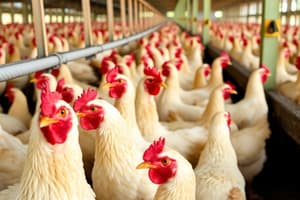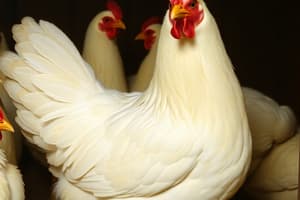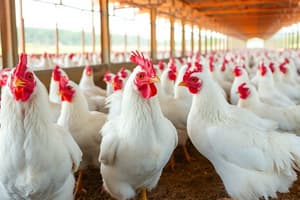Podcast
Questions and Answers
What primary advantage does the consumption of poultry products have in the context of global acceptance?
What primary advantage does the consumption of poultry products have in the context of global acceptance?
- Poultry products have a longer shelf life compared to other meats.
- Poultry production requires advanced technology, promoting its global adoption.
- Poultry products are accepted across diverse cultural and religious backgrounds. (correct)
- Poultry products are cheaper to produce than other meats.
In developing countries, why is poultry production considered socio-economically important for the rural population?
In developing countries, why is poultry production considered socio-economically important for the rural population?
- It mainly supplies fast-food chains.
- It provides access to international markets.
- It serves as a source of livelihood, rituals, and traditions. (correct)
- It requires substantial capital investment.
Compared to other livestock, how do poultry species facilitate faster genetic improvement?
Compared to other livestock, how do poultry species facilitate faster genetic improvement?
- Through shorter generation intervals and higher reproduction rates. (correct)
- Through advanced artificial insemination techniques.
- Through specialized feed formulations.
- Through higher resistance to diseases.
What makes poultry meat and eggs popular in both households and fast-food chains?
What makes poultry meat and eggs popular in both households and fast-food chains?
What characteristic defines broilers versus layers in poultry production?
What characteristic defines broilers versus layers in poultry production?
In the poultry industry, what characterizes vertical integration practiced by commercial integrators?
In the poultry industry, what characterizes vertical integration practiced by commercial integrators?
What role does small-scale poultry production play in underdeveloped and developing countries?
What role does small-scale poultry production play in underdeveloped and developing countries?
Which countries, as of April 2021, were identified as the major producers of poultry meat?
Which countries, as of April 2021, were identified as the major producers of poultry meat?
What was the major contribution of vertical integration and contract growing operations to the global poultry industry?
What was the major contribution of vertical integration and contract growing operations to the global poultry industry?
What characterizes the poultry inventory in underdeveloped and developing countries?
What characterizes the poultry inventory in underdeveloped and developing countries?
Which regions in the Philippines contribute significantly to the country's total chicken meat production?
Which regions in the Philippines contribute significantly to the country's total chicken meat production?
What is the projected trend for the demand for poultry meat and eggs by 2050?
What is the projected trend for the demand for poultry meat and eggs by 2050?
Which country leads the world in egg production, accounting for approximately 34% of the global total?
Which country leads the world in egg production, accounting for approximately 34% of the global total?
What specific aspect is the industry challenged to improve, so it can meet the consumer demand for sufficient, safe, and nutritious poultry products?
What specific aspect is the industry challenged to improve, so it can meet the consumer demand for sufficient, safe, and nutritious poultry products?
What is the per capita consumption of eggs annually in the Philippines?
What is the per capita consumption of eggs annually in the Philippines?
Flashcards
Poultry Industry Growth
Poultry Industry Growth
The fastest growing animal industry globally and in the Philippines.
Broilers
Broilers
Meat-type poultry birds.
Layers
Layers
Egg-type poultry birds.
Vertical Integration in Poultry
Vertical Integration in Poultry
Signup and view all the flashcards
Small-scale poultry importance
Small-scale poultry importance
Signup and view all the flashcards
Top poultry meat producers/consumers
Top poultry meat producers/consumers
Signup and view all the flashcards
Poultry Advantages
Poultry Advantages
Signup and view all the flashcards
Poultry Production Systems
Poultry Production Systems
Signup and view all the flashcards
Major Poultry Industries
Major Poultry Industries
Signup and view all the flashcards
Poultry Production Scales
Poultry Production Scales
Signup and view all the flashcards
Poultry Production Systems
Poultry Production Systems
Signup and view all the flashcards
Poultry Support Industries
Poultry Support Industries
Signup and view all the flashcards
Poultry Improvement Needs
Poultry Improvement Needs
Signup and view all the flashcards
Top poultry meat producers
Top poultry meat producers
Signup and view all the flashcards
Top poultry meat consumers
Top poultry meat consumers
Signup and view all the flashcards
Study Notes
Introduction to Livestock & Poultry Production
- Agri 22 Lecture Syllabus-Introduction to Livestock and Poultry Production was written by Magpantay, V.A. et al. in 2023.
Poultry Production
- Poultry is the fastest growing animal industry globally and in the Philippines.
- Broilers are meat-type birds and layers are egg-type birds.
- The industry is dominated by commercial integrators using vertical integration and contract growing.
- Small-scale poultry production is important in underdeveloped/developing countries as a source of livelihood.
- Top poultry meat producing/consuming countries: United States, China, Brazil, and European Union.
- Brazil is the top poultry meat exporting country, and Japan is the top importing country.
- Asia dominates table egg production.
Advantages of Poultry Production
- Poultry products are acceptable in all countries and religions due to the absence of religious/cultural restrictions.
- Poultry production has socioeconomic importance due to its use in rituals, traditions, and as a source of livelihood among the rural poor in developing countries.
- Poultry species have shorter generation intervals and higher reproduction rates, which enables faster genetic improvement.
- Raising poultry species involves shorter production cycles and minimum inputs, leading to higher economic returns.
- Poultry meat and eggs are popular in households and fast-food chains as they are cheaper and easy to prepare.
Vertically Integrated Poultry Firm
- The world’s poultry industry is dominated by commercial integrators implementing vertical integration and contract growing operations.
- Both schemes started in the United States in the 1950s, which was their contribution to the global poultry industry.
- Poultry production systems range from free-range with night shelter, to automated housing systems.
- Production also varies based on the scale of operation, from backyard raising to commercial integrated systems.
- Most medium to large poultry farms use commercial meat-type and egg-type stocks; these require complete confinement, formulated feeds, and vaccinations.
- Underdeveloped/developing countries' poultry inventory is dominated by native or indigenous breeds.
- The major poultry industry operations include breeder farms, broiler chicken, layer chicken, duck, quail, turkey, native chicken, and game fowl.
- Production scales include small, medium, and large enterprises.
- Production systems include free-range, semi-confinement, and complete confinement.
- Support industries include feed milling companies, equipment/veterinary drug suppliers, transport services, processing plants, packaging industries, and marketing outlets.
Poultry Meat Production & Trade
- By 2050, demand for poultry meat and eggs will double compared to 2005.
- There is a need to improve production efficiency, genetics, nutrition, and overall health management.
- As of April 2021, the major poultry meat producers are the US, China, and Brazil.
- The US and Brazil have advantages in terms of nucleus breeding farms, feed supply, disease management, and advanced technologies.
- The top consumers of poultry meat are China and the US with white meat (turkey/broiler chicken) dominating the US/EU markets.
- As of 2022, the top 4 exporting countries are Brazil, the US, the EU, and Thailand.
- Thailand is the top producer and exporter of poultry meat in Southeast Asia.
- In 2016, the Philippines ranked 16th among world's top broiler meat producers.
- Broiler chickens accounted for 35.7% of the 2022 total of 200.21 million birds.
- Central Luzon, CALABARZON, Northern Mindanao, and Western/Central Visayas contributed to 71.4% of the chicken meat production.
- The average farm gate price of broilers in 2021 was P92.65/kg live weight, a 2.9% increase from 2020.
- In 2021, Filipinos' per capita consumption of poultry meat was 14.05 kg/person/year.
Egg Production & Trade
- In 2020, total world egg production was about 86 million metric tons and there has been a continuous increase globally.
- Rapid population growth has led to egg production increasing tremendously, observing a more than four-fold increase from 1968-2018.
- The Asian region dominates world egg production, holding 60% of the world's total. China, the top egg-producing country, contributes about 34% and the US contributes about 8%.
- Eggs are an important nutrition source due to their wide availability and relatively low price in developing/underdeveloped countries.
Nutritional Value of Eggs
- A large egg (around 50 grams) contains 13% protein, 27% selenium, 11% phosphorus, 25% vitamin B12, 23% choline, 15% riboflavin, and 9% vitamin D based on adult person requirements (FAO 2015).
- 2 minutes to soft boil
- 3 minutes to soft/medium
- 4.5 minutes to medium
- 9 minutes to hard boil
- An average hen lays 300-325 eggs a year.
- Older hens produce larger eggs.
- Egg whites can be frozen for up to a year.
- To tell if an egg is fresh, place it in a glass of water: if it sinks, it's still good.
- If an egg is dropped, sprinkle it heavily with salt for easy clean up.
Egg Consumption and Exportation
- In 2019, the average per capita consumption of eggs in the world was 9.95 kg eggs per person per year.
- Japan had the highest per capita consumption of eggs (320 eggs) in 2018, followed by Paraguay and China.
- The average consumption of eggs in the Philippines is 4.02 kg annually or about 11 grams of egg per person per year (FAO, 2020). This increased by almost 20% from 2003-2013.
- The global export volume of eggs in 2017 was approximately 2.8 million tonnes: 78.66% chicken eggs (in shell), 13.03% liquid egg, 2.52% fried egg, and 5.80% other poultry eggs.
- In 2020, the top 5 exporting countries of chicken eggs (in shell) are the Netherlands, Poland, Turkey, Germany, and Malaysia.
- Malaysia had the highest export volume of eggs in Asia, followed by China.
- The Netherlands and USA are the top exporting countries of liquid egg and dried egg, respectively.
- Top importer of eggs (in shell, liquid, dried forms) in 2017 was Germany (FAO, 2020).
- The Philippines ranked 28th in the 2018 world egg production (FAO, 2020).
- Chicken and ducks are the most popular poultry species being raised.
- In 2022, the total inventory of layer chicken was recorded at 65.97 million birds.
- Total chicken layer population increased by 6% compared to inventory in 2010.
- CALABARZON was the top producer of chicken eggs.
- In terms of economic importance, ducks ranked second to chickens. As of September 2022, the total duck population was about 13.61 million birds (PSA, 2022).
Industry Prospects
- The poultry industry has a bright prospect in the animal sector.
- Improving production efficiency, value, and supply chains, are still at the forefront because global issues are a challenge.
- In order to continue to provide more nutritious and cheaper protein for the increasing population, the industry must address:
- Food security versus self-sufficiency
- Food safety and quality
- Product standards and innovative product development (i.e., salted egg chips, balut in vending machines)
- Changing consumer preferences (whole vs cut-ups, deboned, pre-cooked meals)
- Importation of poultry products, marketing systems (non-formal vs formal and institutional)
- Emerging and re-emerging poultry and zoonotic diseases
- Animal welfare issues (i.e., caged birds)
- Environmental concerns
Studying That Suits You
Use AI to generate personalized quizzes and flashcards to suit your learning preferences.




